Water fern is a common name for several plants and may refer to:
Parablechnum monomorphum, synonym Blechnum monomorphum is a species of fern in the family Blechnaceae. It is native to Colombia (Antioquia), Ecuador and Bolivia.
Blechnum sociale is a species of fern in the family Blechnaceae. It is endemic to Pichincha Province and Azuay Province, Ecuador, but has not been recorded since 1893. The name sociale indicates that they form in colonies. It was first described by Sodiro in 1883. In 1893, Sodiro transferred it to Lomaria as Lomaria socialis. He said that the most similar species was Lomaria stipitellata, now placed in Parablechnum as Parablechnum stipitellatum. The status and taxonomy of Blechnum sociale was unclear as of 2003.
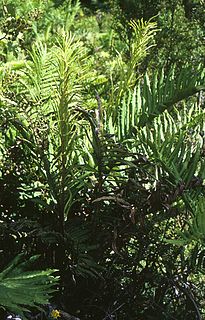
Parablechnum cordatum, the Chilean hard fern or costilla de vaca, is a fern of the family Blechnaceae, native to Chile. It is also found in neighboring areas of Argentina and the Juan Fernández Islands.

Lomariocycas magellanica, synonym Blechnum magellanicum, costilla de vaca or palmilla, is a medium-sized fern native with a natural range from Talca at 35°S, to the Magallanes Region in Chile. It grows from sea level up to 2200 m.a.s.l. It grows also in the humid valleys of western Argentina close to the Chilean border.

Luteolinidin is a member of the 3-deoxyanthocyanidins. It is a cation with ill-defined anions. This orange species that can be found in Sorghum bicolor.
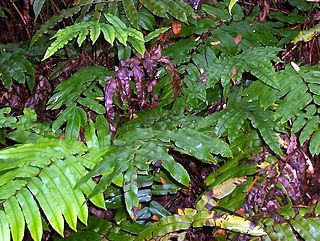
Parablechnum wattsii, synonym Blechnum wattsii, is a common terrestrial fern growing in rainforest and open forest. It is often seen near creeks in much of south eastern Australia, including Victoria, Tasmania, South Australia, New South Wales and Queensland. The specific epithet wattsii honours William Walter Watts (1856-1920). Watts was considered an authority on mosses and ferns and has more than 30 species named for him. Common names by which the species may be called are hard water fern - from its stiff leathery fronds, leech fern - as forest workers often encounter leaches while working in clusters of these ferns, hard hill fern - from the fern's habit and habitat, and red cabbage fern - from the bronze-pink colour of the young fronds resembling cooked red cabbage.

Parablechnum ambiguum, synonym Blechnum ambiguum, is a species of fern in the family Blechnaceae. growing on wet rocks in eastern Australia, often seen near waterfalls. It is common around Sydney.
Kiokio is a Māori word that may refer to:
Victoria, Australia contains approximately 32,000 hectares of temperate rainforest in various regions, which represents 0.14% of the State's total area. The areas with rainforest include: East Gippsland, Strzelecki Ranges, Wilsons Promontory, Central Highlands, and Otway Ranges. The rainforests vary between cool temperate, warm temperate, and mixed cool temperate.

Parablechnum minus, synonym Blechnum minus, is a small fern growing in moist situations in a variety of habitats in eastern Australia. It is often seen by streams.
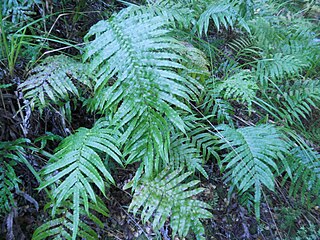
Parablechnum novae-zelandiae, synonym Blechnum novae-zelandiae, commonly known as palm-leaf fern or kiokio, is a species of fern found in New Zealand. It can often be found growing in clay soil on embankments and roadsides.

Parablechnum howeanum, synonym Blechnum howeanum, is a fern in the family Blechnaceae. The specific epithet refers to the locality to which it is endemic.

Parablechnum gregsonii, synonym Blechnum gregsonii, is a type of fern, mostly seen in the Illawarra and Blue Mountains areas of eastern Australia, often near waterfalls and moist gullies.
Kio Kio or Kiokio is a rural community in the Otorohanga District and Waikato region of New Zealand's North Island. It is located just north-east of Otorohanga, on State Highway 3 between Otorohanga and Te Awamutu.
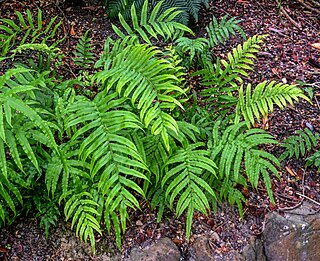
Parablechnum is a genus of ferns in the family Blechnaceae, subfamily Blechnoideae, according to the Pteridophyte Phylogeny Group classification of 2016. The genus is accepted in a 2016 classification of the family Blechnaceae, but other sources sink it into a very broadly defined Blechnum, equivalent to the whole of the PPG I subfamily.
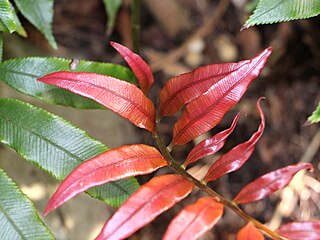
Parablechnum articulatum, synonym Blechnum articulatum, is a species of fern in the family Blechnaceae. The common name is rosy water fern. Often seen growing on wet stream banks, at higher altitudes in tropical Queensland, Australia.
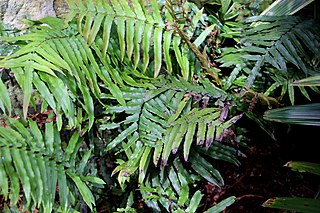
Parablechnum camfieldii, synonym Blechnum camfieldii is known as the eared swamp fern. Often found near saline areas, or low-lying coastal sites in eastern Australia. The new growth is often pink in colour. Named after Julius Henry Camfield (Wd), a gardener at the Royal Botanic Gardens, Sydney.












